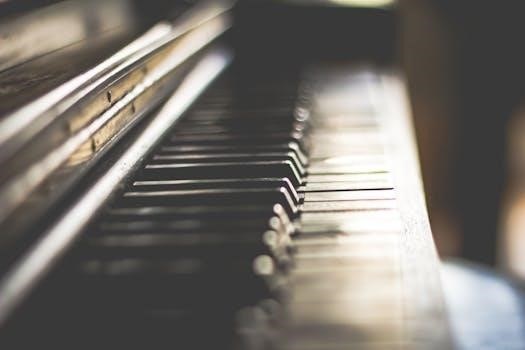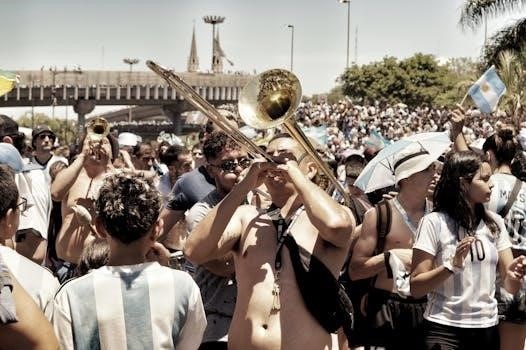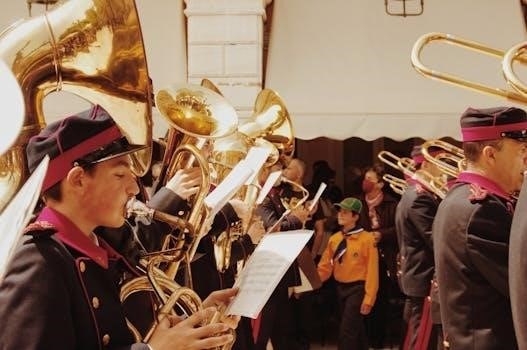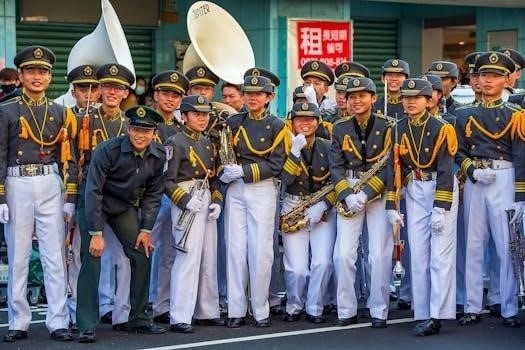Overview of Rimsky-Korsakov’s Trombone Concerto
Composed in 1877, Rimsky-Korsakov’s Trombone Concerto is a cornerstone of the trombone repertoire. This work, originally for trombone and military band, showcases the instrument’s melodic and technical capabilities. It remains a beloved piece for both performers and audiences.
Composition and Purpose
Nikolai Rimsky-Korsakov composed his Trombone Concerto in 1877, dedicating it to his friend, a marine officer named Leonov, who was a talented trombonist. The piece was intended to highlight the expressive potential of the trombone, an instrument often relegated to supporting roles within orchestral music. Rimsky-Korsakov sought to create a work that would both showcase the trombone’s technical agility and its capacity for lyrical melody. It was initially conceived for solo trombone and military band, reflecting the composer’s naval background and his desire to provide a prominent feature for the instrument within that setting. The concerto was designed to be both virtuosic and engaging, offering a challenge to the soloist while remaining accessible and enjoyable for listeners. The piece’s three-movement structure allowed for a variety of moods and tempos, further demonstrating the trombone’s versatility. The composition serves as a valuable contribution to the instrument’s solo literature.

Historical Context
The Trombone Concerto was written during the Romantic era. Rimsky-Korsakov composed this piece in 1877. It was a time when composers explored new instrumental colors. This concerto became a significant work for the trombone.
Rimsky-Korsakov’s Background
Nikolai Rimsky-Korsakov, born into a Russian aristocratic family, initially pursued a career in the Imperial Navy. His early musical education was limited, and he was not initially destined for a musical path. However, a pivotal meeting with Mily Balakirev in 1861 reignited Rimsky-Korsakov’s passion for music, awakening his latent talents. This encounter marked a significant turning point in his life, steering him towards a career in composition. By 1871, he secured a professorship at the Saint Petersburg Conservatory, solidifying his position as a prominent figure in Russian music. Despite his naval background, Rimsky-Korsakov became a prolific composer, known for his colorful orchestrations and distinct musical style. His works often reflect his interest in Russian folklore and mythology. His dedication to music eventually overshadowed his naval obligations, and he fully embraced his role as a composer and educator. This transition highlights his remarkable journey from a naval officer to one of Russia’s most celebrated composers.
Commission and First Performance
Rimsky-Korsakov composed his Trombone Concerto in 1877, dedicating it to his friend, a marine officer named Leonov, who was also a skilled trombonist. This commission was a personal endeavor for Rimsky-Korsakov, inspired by his admiration for Leonov’s musical abilities and the potential of the trombone as a solo instrument. The concerto was originally conceived for trombone and military band, a common ensemble at the time. The first public performance of the concerto took place in Kronstadt in 1878, with Leonov himself as the soloist and Rimsky-Korsakov conducting the band. This premiere marked a significant moment for both the composer and the trombone, showcasing its lyrical and technical range. The performance was met with positive reception, establishing the concerto as an important work in the trombone repertoire. The composition’s connection to a personal friendship and a specific performer adds a unique layer to its historical context. The initial performance solidified its place as a piece worthy of repeated performances and study.

Musical Structure
The concerto is in three movements⁚ Allegro Vivace, Andante Cantabile, and Allegro-Allegretto. The last movement is a march. The second and third movements feature cadenzas for the soloist, showcasing the trombone’s virtuosity.
Movement Breakdown
The first movement, Allegro Vivace, is a vibrant and energetic opening, characterized by its brisk tempo and lively melodies. It immediately establishes the trombone as a powerful and agile solo instrument. The movement displays a clear sense of forward motion, with contrasting thematic material providing both dramatic and lyrical moments. The technical demands on the soloist are evident from the outset, setting the stage for the concerto’s bravura nature. The overall feel is one of spirited exuberance, showcasing both the trombone’s technical capabilities and its expressive potential. The movement moves with a sense of purpose, leading the listener through a well-defined musical argument.
The second movement, Andante Cantabile, provides a beautiful contrast, offering a lyrical and expressive showcase for the trombone. This movement is slower and more introspective, allowing the soloist to demonstrate the instrument’s capacity for melodic beauty. It allows for a moment of reflection before the exuberant ending. The singing quality of the trombone is highlighted.The third movement, Allegro-Allegretto, brings the concerto to a close with a march-like character, full of rhythmic drive and melodic appeal. This is a lively and energetic conclusion to the concerto.
Instrumentation
The original instrumentation of Rimsky-Korsakov’s Trombone Concerto is for solo trombone and military band. This setting highlights the trombone’s soloistic capabilities against the backdrop of the band’s rich sonority. The wind band provides a vibrant and colorful soundscape, complementing the trombone’s unique timbre. The military band typically includes a variety of woodwinds, brass, and percussion instruments. This creates a full and robust texture. The wind band instrumentation allows for a wide dynamic range, from delicate passages to powerful and impactful moments. The combination of the solo trombone and the wind band creates a dynamic and engaging musical experience.
The standard instrumentation includes flutes, oboes, clarinets, bassoons, horns, trumpets, trombones, euphoniums, tubas, and percussion. This large ensemble allows for a rich and varied sound, providing a solid foundation for the solo trombone. Numerous arrangements for different ensembles exist today, including versions for trombone and piano, brass quintet and full orchestra. Such a wide variety of arrangements speaks to the versatility and lasting appeal of Rimsky-Korsakov’s work.

Performance and Editions
Rimsky-Korsakov’s Trombone Concerto is widely performed, with various editions available. These editions include versions for different ensembles, such as trombone and piano. Modern performances often utilize revised scores, ensuring consistency and clarity.
Arrangements for Different Ensembles
The enduring popularity of Rimsky-Korsakov’s Trombone Concerto has led to numerous arrangements for various ensembles, expanding its accessibility and performance opportunities. Originally conceived for solo trombone and military band, the piece has been adapted for settings such as trombone and piano, allowing for more intimate performances and practice. These arrangements often maintain the core musical content, while adapting the accompaniment to suit the available instrumentation. Brass quintet arrangements also exist, providing a different textural experience. These versions demonstrate the flexibility of the composition and its ability to resonate in diverse instrumental contexts. Furthermore, orchestral versions have been created, enriching the sonic palette and offering a more symphonic approach to the work. These diverse arrangements not only increase the availability of the concerto but also showcase the versatility of the trombone itself, proving its adaptability in different musical frameworks. The availability of both full orchestral and smaller chamber versions is what makes this concerto such a widely-played and beloved piece. The arrangements cater to a wide range of performance settings, from concert halls to classrooms. The varied transcriptions highlight the melodies and harmonies, making them accessible to a wider audience. These adaptations highlight the piece’s timelessness and appeal.
Available Scores and Parts
Numerous editions of the Rimsky-Korsakov Trombone Concerto are readily available, catering to various performance needs and preferences. These include complete scores, solo trombone parts, and accompanying parts for piano, military band, and other ensembles. Publishers like Boosey & Hawkes, and Kalmus Edition offer widely recognized versions, providing performers with reliable and well-edited material. Many online platforms, such as Musescore and IMSLP, also provide access to free or purchasable digital scores and parts. These resources often include both original and arranged versions, ensuring that musicians can find suitable materials for their specific performance contexts. Some scores have also been edited with specific articulation and dynamic markings. Piano reductions are essential for solo practice and rehearsal purposes. These reductions aim to capture the essence of the original orchestration, making them helpful for trombonists to study the piece. There are also versions that include a conductor’s score, which is necessary for the full orchestral or band performances. Sheet music is available in both PDF and printed formats, catering to diverse preferences. The abundance of available scores and parts contributes to the concerto’s popularity and frequent performance, making it a staple in the trombone repertoire. These options ensure accessibility for performers worldwide.

Legacy
The Rimsky-Korsakov Trombone Concerto holds a significant place in trombone repertoire and is frequently performed. Its enduring popularity is due to its lyrical melodies and technical demands, inspiring trombonists for generations. It’s a classic piece.
Significance in Trombone Repertoire
Rimsky-Korsakov’s Trombone Concerto is undeniably a landmark work, holding immense significance within the trombone repertoire. Composed in 1877, it stands as one of the earliest and most successful concertos for the instrument, effectively showcasing its lyrical and virtuosic capabilities. Before this piece, the trombone was often relegated to supporting roles in orchestral music. However, Rimsky-Korsakov’s concerto elevated it to a prominent solo position, demonstrating its potential for both melodic expression and technical brilliance. This work inspired many subsequent composers to explore the trombone’s soloistic possibilities, solidifying its place as a viable solo instrument. Its enduring popularity is a testament to its musical quality and the composer’s understanding of the instrument’s unique character. The concerto continues to be a staple in auditions, recitals, and orchestral programs, demanding technical proficiency and musical interpretation from every trombonist who undertakes it. It serves as a crucial benchmark in the development of the trombone’s solo repertoire and remains a beloved piece for performers and listeners alike, further cementing its pivotal role.
Contemporary Performances and Recordings
The Rimsky-Korsakov Trombone Concerto enjoys widespread popularity in contemporary performances and recordings, solidifying its position as a beloved piece. Numerous professional trombonists regularly include it in their recital programs, showcasing their technical prowess and interpretative skills. This concerto is a frequent feature in orchestral concerts, highlighting the instrument’s soloistic capabilities. The availability of various editions and arrangements facilitates diverse performances, from those with piano accompaniment to those with wind band or full orchestra. Many recordings exist, offering varied interpretations by renowned trombonists, allowing audiences to explore different approaches to the piece. These recordings are accessible through various digital platforms like Spotify and YouTube, making the concerto readily available to music enthusiasts worldwide. The continued interest in this work is also evident in its presence on streaming services and sheet music websites, indicating its relevance in modern musical culture. The ongoing performances and recordings of Rimsky-Korsakov’s Trombone Concerto ensure its continued appreciation and influence on the world of music for years to come. Furthermore, this sustained interest guarantees its place in the standard repertoire for trombone soloists.
